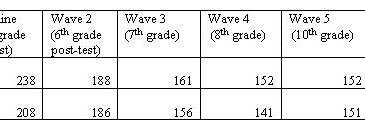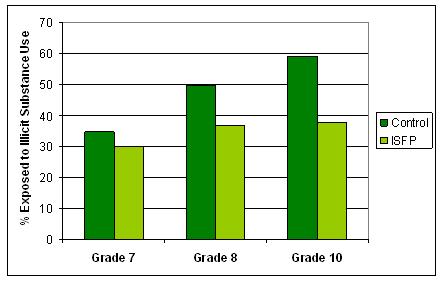Exposure to, and use of, substances during early adolescence is associated with increased risk of escalating use, abuse, and dependence later in life (Agrawal et al., 2006; Grant & Dawson, 1997; Van Etten, Neumark, & Anthony, 1997). Researchers have identified factors associated with reductions in opportunities to engage in substance use, such as parenting practices that emphasize adolescent monitoring and non-coercive discipline (Chen, Storr, & Anthony, 2005). This week’s STASH reviews the findings of a family level intervention program focusing on adolescent contact with illicit drugs (Spoth, Guyll, & Shin, 2009).
Methods
- Researchers randomly assigned 22 rural Iowa schools to receive either the Iowa Strengthening Families Program (ISFP, N=11) or no intervention, with minimal researcher contact with participants (Control, N=11).
-
- Of the families eligible for participation in the study (i.e., they had children in the 6th grade), fifty three percent completed pre-testing (ISFP N = 238, Control N = 208).
- Of those completing pre-testing in the ISFP group, 49% of families (N = 117) attended the ISFP intervention for an overall intervention response rate of 26%.
- The ISFP program provided families of sixth graders with seven evening prevention sessions including content presented to parents alone, adolescents alone, and both groups simultaneously.
-
- Parents received information about parenting practices that have been shown to reduce adolescent risk of initiating drug use.
- Adolescents received information about peer interactions and social skill development.
- Students who completed the baseline test provided follow-up information about illicit drug exposure and drug use experience at the end of 6th, 7th, 8th, 10th, and 12th grade. As Table 1 shows, the ISFP group (N=238) included both students who attended the ISFP sessions (N=117) and those who only completed the pre-test (N=121).
Figure. Assessment participation (adapted from Iowa State University Partnerships in Prevention Science Institute Participation figure). Click image to enlarge.
Results
- ISFP participating adolescents were less likely to be exposed to illicit substance use than the control group adolescents, with statistically significant differences observed at the grade 8 (p=0.014) and grade 10 (p<0.001) interviews.
- ISFP participating adolescents were about 2 times less likely than control group adolescents to have engaged in illicit substance use by grade 12 (15.5% of ISFP participants vs. 30.1% of Controls, OR=2.34; 95% CI = 1.34, 4.12; p = 0.002).
Figure. Illicit Substance Use Exposure (adapted from Spoth, Guyll, & Shin, 2009). Click image to enlarge.
Limitations
- Researchers included all 238 pre-tested students in the ISFP group but provided no justification for expecting an intervention effect among the 121 students who did not receive the intervention.
- The recruitment (53%) and participation rates (49%) for the study are low and rate of participation at follow-up varies across study waves (Table 1). It is possible that factors related to non-participation also might be related to substance exposure and use, which could confound the study results.
- The study population was predominantly white and from rural areas. Consequently, these results might not generalize to urban/suburban or ethnically diverse populations.
- This study relies on self-report of illicit drug exposure and use.
- The illicit drug use assessment did not ask specifically about misuse of prescription drugs, but included the category of “other.” The study results might underestimate the actual rates of prescription drug misuse.
Conclusion
The authors concluded that the results of this study indicate that an intervention targeting young adolescents and their parents provided a protective shield against illicit substance use initiation via reductions in exposure to illicit drugs. They attribute the protective effect to alterations in parental behaviors that limit adolescent exposure to illicit drugs. Further research will be needed to address the limitations of this study, particularly to elucidate the effects of combining ISFP participants and non-participants in the intervention group for analysis and to explore the potential impact of low rates of participation at baseline and varying follow-up rates. Until these limitations are addressed, it is difficult to judge from this study the potential of intervention techniques in early adolescence to reduce harm by effecting behavior long after program participation.
-Erica Marshall
What do you think? Please use the comment link below to provide feedback on this article.
References
Agrawal, A., Grant, J. D., Waldron, M., Duncan, A. E., Scherrer, J. F., Lynskey, M. T., et al. (2006). Risk for initiation of substance use as a function of age of onset of cigarette, alcohol and cannabis use: findings in a Midwestern female twin cohort. Preventive Medicine, 43(2), 125-128.
Chen, C. Y., Storr, C. L., & Anthony, J. C. (2005). Influences of parenting practices on the risk of having a chance to try cannabis. Pediatrics, 115(6), 1631-1639.
Grant, B. F., & Dawson, D. A. (1997). Age at onset of alcohol use and its association with DSM-IV alcohol abuse and dependence: results from the National Longitudinal Alcohol Epidemiologic Survey. Journal of Substance Abuse, 9, 103-110.
Spoth, R., Guyll, M., & Shin, C. (2009). Universal intervention as a protective shield against exposure to substance use: long-term outcomes and public health significance. American Journal of Public Health, 99(11), 2026-2033.
Van Etten, M. L., Neumark, Y. D., & Anthony, J. C. (1997). Initial opportunity to use marijuana and the transition to first use: United States, 1979-1994. Drug and Alcohol Dependence, 49(1), 1-7.







Gerald A. Bunn, MA December 16, 2009
I agree that the limitations cited by the authors are significant enough to impact the possible conclusions. One of the major variables that I have found in working with young people, and thier families, is that often those who participate in programs such as this often are pre-disposed to positive family behaviors in the first instance.
David Anderson December 17, 2009
Thank you for writing up these important new findings from the Iowa Strengthening Families randomized trial. I just wanted to offer a clarification regarding the first study limitation you listed.
The fact that the researchers included all pretested students in the ISFP group in their analysis regardless of whether they participated in the intervention (i.e., an intention-to-treat analysis) is actually an important strength of the study for two reasons:
1) It helped insure that the baseline equivalence of the ISFP and control groups (established through random assignment) was maintained at follow-up. Had the researchers only included ISFP students who received the program, they would have introduced key differences between the groups and thus possible alternative explanations for the study’s findings. For example, ISFP group families who participated in this voluntary program likely were more motivated on average to prevent their children’s substance use than families who chose not to participate in the program. Assuming this was true, if the trial had dropped from its analysis the ISFP group students whose families didn’t participate, leaving only the students from the most motivated families, it would have created a systematic difference between the ISFP and control groups – namely, motivation level. This would have made the study unable to determine whether any observed differences in substance use between the groups was due to ISFP as opposed to the groups’ motivational differences.
2) Conducting the analysis as they did provides the most policy relevant test of the program’s effectiveness under real-world implementation conditions. Realistically, not all people who are offered a voluntary program will participate in it (as borne out in the study). So, comparing the substance use outcomes for all people offered the program vs. an equivalent group of people who were not, provides policymakers with an accurate estimate of the likely population-wide effects of offering it to another population, assuming it is similar to the study population.
TruthAboutAbs--Review.blogspot.com December 1, 2013
This is the perfect webpage for anybody who hopes to find out about this topic. You know a whole lot its almost hard to argue with you (not that I personally would want to…HaHa). You certainly put a brand new spin on a subject which has been written about for decades. Excellent stuff, just great!